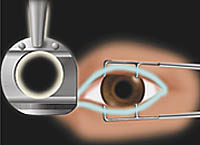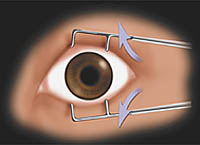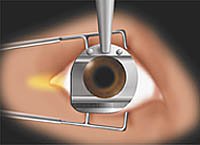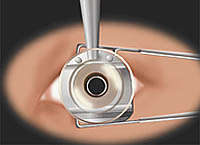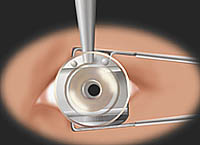With proper technique, you can overcome the challenge of LASIK in Asian patients
Several techniques help surgeons perform LASIK on patients with small eyes or eyelids.
The success of laser in situ keratomileusis (LASIK) depends on making a good corneal flap. Many of our Asian patients have small eyes with narrow eyelid fissures. This can cause extra challenges for LASIK surgery. When this challenge is recognized, we can get a good corneal flap and prevent poor surgical results, but it makes the LASIK surgery more challenging.
When you have a patient with a small eyelid opening, you will have difficulty putting the suction ring onto the eyeball. In patients whose eyelid fissure is narrow, usually the lid speculum will fit, but the eyelid cannot open wide, so the suction ring cannot get past the lid speculum to work properly.
Stretch, press and lift
A good corneal flap is important for a good LASIK result. To have adequate intraocular pressure (IOP) is a must before you can make a good corneal flap. The applanation tonometer helps to find a safe pressure before cutting the cornea.
When the darker contact circle is larger than the white reference circle, the IOP is too low. Cutting can result in a poor corneal flap. When the darker contact circle is smaller than the white reference circle, cutting will result in a good corneal flap. This is a very important step in successful LASIK surgery.
The cause of the low IOP must be checked before making the corneal flap.
To overcome the problem of a narrow eyelid fissure, try this maneuver: stretch and widen the eyelid with the speculum; at the same time press down on the speculum. The eyeball will protrude. This will allow the suction ring to be in contact with the eyeball. When suction is turned on, the eyeball can be lifted gently in the orbit. The IOP then can be checked before making the corneal flap.
When the lid speculum is applied in a patient with a narrow eyelid fissure, the suction ring cannot fit to get hold of the eyeball. With a lid speculum spread, the narrow eyelid is opened as wide as possible, and as the pressure is directed down toward the orbital apex, the eyeball will protrude. When the suction is turned on, the suction ring is lifted slightly outward. The inner darker circle of the applanation tip will become smaller than the white reference circle. This means the IOP is higher and is safer for the keratome to cut and make the corneal flap.
Minicanthotomy
If the maneuver to spread the lids open fails, a minicanthotomy can help. A 2-mm to 3-mm incision at the lateral canthus will allow the suction ring to make contact with the eyeball and raise the IOP to a satisfactory level.
In patients with very narrow eyelid fissures, the stretch, press and lift maneuver may not work and the suction ring is unlikely to hold the eyeball, so we have to make a minicanthotomy on the lateral canthus in order to widen the eyelid fissure slightly.
A small amount of infiltration anesthesia with lidocaine 1% (Xylocaine, lidocaine HCl injection, USP, AstraZeneca LP) is injected into the lateral canthus. A small area is clamped with a hemostat before cutting. This will prevent bleeding and usually needs no suture after the surgery. Excessive Xylocaine should be avoided and wiped off from the incision. Too much Xylocaine can cause corneal epithelial sloughing.
After the canthotomy, the suction ring now can hold the eyeball to produce an effective IOP. The applanation tonometer should show a darker ring smaller than the white reference circle. The IOP now is adequate to continue with making the corneal flap.
Inferior cul-de-sac
With what appears to be proper positioning of the suction ring, sometimes IOP will not reach an adequate level. In a small eye, the inferior conjunctiva moves forward. The suction port tends to be blocked by the loose tissue, and the IOP cannot be raised to a satisfactory level and remains low.
After suction is released, the telltale signs of a red bump can be detected in the inferior cul-de-sac. This marks the location for the loose conjunctiva, moving forward in a small eye and blocking the suction port.
In patients with small eyes, the suction port of the suction ring is located inferiorly, so the IOP cannot reach an acceptable level. IOP can be persistently low, even though the suction ring appears to be on the eyeball. When the suction ring is released and removed, examination of the inferior cul-de-sac shows the problem. Persistently low IOP is caused by the red dot. In the inferior cul-de-sac is the swollen, congested conjunctiva.
This red dot blocks the suction port. The persistent lower IOP is the result of this blockage.
To correct this problem, an angle forceps can be used to sweep the conjunctiva and hold it away from the blocking of the suction port before turning on the suction. After this maneuver, the persistent low IOP will be corrected, the IOP will be high and creation of the corneal flap then can continue.
|
|
| |
|
|
| |
|
|
| |
|
| ||
|
| ||
|
|
| |
For Your Information:
- Guy Chan, MD, FACS, is professor emeritus of ophthalmology at Temple University in Philadelphia and director of the Refractive Surgery Center of Hong Kong. He can be reached at the Department of Ophthalmology, Refractive Surgery Center, Hong Kong Sanatorium & Hospital, 5/F Central Block, 2 Village Road, Happy Valley, Hong Kong, China; +(852) 28-35-88-99; fax: +(852) 28-35-80-08; e-mail: guychan@hk.net. Dr. Chan has no direct financial interest in any of the products mentioned in this article, nor is he a paid consultant for any companies mentioned.

